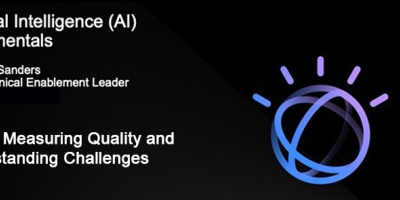I don’t know about you, but right now I am totally confused about what each of the three Natural Language APIs do. You with me, dude?
In the past months, we’ve looked at Watson’s Natural Language APIs. If you’re totally clear on what the three Natural Language APIs do, then you can skip this article. But if you’re like me and get seriously confused about the differences among the three, you may want to read on.
Does it seem odd to you that Watson has three Natural Language APIs? I mean they have only two for the translation side: text to voice and voice to text. So why so many to look at language?
First Thing
The first thing we need to remember is that we are talking about “natural” language.
Natural Language is structurally different from what most Business Intelligence systems do. Most of them are based on “structured” language—that is, language that has been manipulated and put into a format that is easy for BI systems to understand. In short, a structured language passage removes the ambiguity and looseness that is present in a normal conversation or text section.
But Natural Language systems, thanks to Watson, are able to compensate for that. And that means what? It means these APIs can cut a bunch of time and cost off of any BI initiative.
Differences (and Similarities)
Below I’ve listed the Natural Language APIs (three of the most common Watson APIs) and revealed how they are similar and different.
Natural Language Translator
This is not a difficult one to separate from the herd. It takes a text document from one of the supported languages and translates it to another language. Nothing fancy, just a translator, word (or phrase) by word (or phrase).
This API supports a number of languages at this point, and we can assume the number will grow as the API matures. Right now, the translation supports English, French, German, Italian, Japanese, Korean, Portuguese/Brazil, Spanish, Chinese (Simple), and Chinese (Traditional). That’s a few of the most common ones.
This API was covered in the May TechTip. Did you read it? You can still see the article and learn more.
Natural Language Classifier
This is not translation-oriented, but rather deals with intent. It was covered in the June TechTip. It takes a piece of text from one language (see above list) and renders it in the next language with intent as the goal. The essence here is to look at the keywords, relationships, entities, categories, and concepts that define what is important in a given text snippet. And when I say “snippet,” I’m definitely talking about a snippet because the Classifier is question-and-answer-oriented. The most important thing to remember is that the NLC is designed not for a lengthy text section, as the other language APIs are, but for a much shorter text snippet—specifically, a question or statement.
The idea is to take the snippet and determine what the verbiage was about. Probably, this is ideally suited to customer service applications. What is this customer really calling in about? Why did a particular customer ask that particular question? Was she unsure how the product worked? Was he unsure how to put it together? Does his service (or the product) not work at all? Or is it a problem with a specific portion of the product or service? Does she not understand how to assemble the item? Or is setup the issue? What was the overriding issue that led him to ask this question?
Seems unimportant maybe, but if you can get a handle on what most customers (or new as opposed to veteran customers) are having trouble with, you can update both your AI bots (including the automated portion of your telephone help line) as well as your human operators so that they can isolate the real problem quicker.
Natural Language Understanding
The NLU looks at text passages, not just questions. And it works on finding insights into both the emotion and the concepts behind a text sample and returning a “confidence” rating. This one was covered in a July TechTip.
The NLU makes a distinction between sentiment and emotions. Sentiment is a single value, but emotion is split into joy, sadness, disgust, anger, and fear. From there, we go into entities (physical things that were actually talked about in the piece), keywords, concepts, and categories.
The thing I like about this one is that I tend to think of keywords and entities as being fairly specific, whereas concepts and categories are a little more open-ended.
What bothered me was that the API seemed to go for very solid and real keywords or concepts, rather than reading between the lines. Perhaps that will come with time, or perhaps it was my imagination. And for most business writing, there shouldn’t be too much that is not explicitly spelled out.
Summary
Three different APIs. All dealing with “natural” language issues. And each with a slightly different theme.
It depends on your needs, of course, but using them together, in twos or threes (or fours if you include the other APIs), may be a very effective way to deal with your company’s needs.

























 More than ever, there is a demand for IT to deliver innovation. Your IBM i has been an essential part of your business operations for years. However, your organization may struggle to maintain the current system and implement new projects. The thousands of customers we've worked with and surveyed state that expectations regarding the digital footprint and vision of the company are not aligned with the current IT environment.
More than ever, there is a demand for IT to deliver innovation. Your IBM i has been an essential part of your business operations for years. However, your organization may struggle to maintain the current system and implement new projects. The thousands of customers we've worked with and surveyed state that expectations regarding the digital footprint and vision of the company are not aligned with the current IT environment. TRY the one package that solves all your document design and printing challenges on all your platforms. Produce bar code labels, electronic forms, ad hoc reports, and RFID tags – without programming! MarkMagic is the only document design and print solution that combines report writing, WYSIWYG label and forms design, and conditional printing in one integrated product. Make sure your data survives when catastrophe hits. Request your trial now! Request Now.
TRY the one package that solves all your document design and printing challenges on all your platforms. Produce bar code labels, electronic forms, ad hoc reports, and RFID tags – without programming! MarkMagic is the only document design and print solution that combines report writing, WYSIWYG label and forms design, and conditional printing in one integrated product. Make sure your data survives when catastrophe hits. Request your trial now! Request Now. Forms of ransomware has been around for over 30 years, and with more and more organizations suffering attacks each year, it continues to endure. What has made ransomware such a durable threat and what is the best way to combat it? In order to prevent ransomware, organizations must first understand how it works.
Forms of ransomware has been around for over 30 years, and with more and more organizations suffering attacks each year, it continues to endure. What has made ransomware such a durable threat and what is the best way to combat it? In order to prevent ransomware, organizations must first understand how it works. Disaster protection is vital to every business. Yet, it often consists of patched together procedures that are prone to error. From automatic backups to data encryption to media management, Robot automates the routine (yet often complex) tasks of iSeries backup and recovery, saving you time and money and making the process safer and more reliable. Automate your backups with the Robot Backup and Recovery Solution. Key features include:
Disaster protection is vital to every business. Yet, it often consists of patched together procedures that are prone to error. From automatic backups to data encryption to media management, Robot automates the routine (yet often complex) tasks of iSeries backup and recovery, saving you time and money and making the process safer and more reliable. Automate your backups with the Robot Backup and Recovery Solution. Key features include: Business users want new applications now. Market and regulatory pressures require faster application updates and delivery into production. Your IBM i developers may be approaching retirement, and you see no sure way to fill their positions with experienced developers. In addition, you may be caught between maintaining your existing applications and the uncertainty of moving to something new.
Business users want new applications now. Market and regulatory pressures require faster application updates and delivery into production. Your IBM i developers may be approaching retirement, and you see no sure way to fill their positions with experienced developers. In addition, you may be caught between maintaining your existing applications and the uncertainty of moving to something new. IT managers hoping to find new IBM i talent are discovering that the pool of experienced RPG programmers and operators or administrators with intimate knowledge of the operating system and the applications that run on it is small. This begs the question: How will you manage the platform that supports such a big part of your business? This guide offers strategies and software suggestions to help you plan IT staffing and resources and smooth the transition after your AS/400 talent retires. Read on to learn:
IT managers hoping to find new IBM i talent are discovering that the pool of experienced RPG programmers and operators or administrators with intimate knowledge of the operating system and the applications that run on it is small. This begs the question: How will you manage the platform that supports such a big part of your business? This guide offers strategies and software suggestions to help you plan IT staffing and resources and smooth the transition after your AS/400 talent retires. Read on to learn:
LATEST COMMENTS
MC Press Online